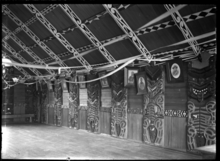Hine-nui-te-pō
Hine-nui-te-pō ("Great woman of night") in Maori legends, is a goddess of night and she receives the spirits of humans when they die. She is the daughter of Tane Mahuta / Tane Tuturi and Hine-ahuone. It is believed among Maori that the colour red in the sky comes from her. Hine nui te Po Shepherds the Wairua/souls into the underworld to ready them for the next stage of their journey.


Background
Hine-nui-te-pō, also known as the "Great Woman of Night" is a giant goddess of death and the underworld.[1] Her father is Tāne, the god of peace and beauty. Her mother is a human, Hine-ahu-one was made from earth. Hine-nui-te-pō is the second child of Tāne and Hine-ahu-one. Her birth name, Tikikapakapa, was changed shortly thereafter to Hine-au-tauria.[2] Hine-au-tauria marries her father Tāne and bears his children. She realizes he is her father, becomes ashamed, and goes down to the underground world, known as Pō ("darkness"). There she becomes Hine-nui-te-pō, acquiring men's souls while her father Tāne tries to lead them to light.[2]
Māui's encounter with Hine-nui-te-pō
The great demi-god, Māui is tricked by his father into thinking he has a chance to achieve immortality. In order to obtain this, Māui is told to enter into the goddess through her vagina. While Hine-nui-te-pō is asleep, Māui undresses himself ready to enter himself into the goddess. One of his bird friends, the fantail, warned Hinenui-te-po of the situation and woke her. As Māui turned into a worm squirming to enter the goddess, Hinenui-te-po decide to punish the demi-god, she crushed him with the obsidian teeth in her vagina; Māui was the first man to die.[1][3]
See also
- Māui (Māori mythology)
- Vagina dentata
- B.G. Biggs, 'Maori Myths and Traditions' in A. H. McLintock (editor), Encyclopaedia of New Zealand, 3 Volumes. (Government Printer: Wellington), 1966, II:447-454.
References
- Westervelt, William Drake (1913). Legends of Maui: A Demi God of Polynesia and of his Mother Hina. Library of Alexandria. ISBN 9781465527172.
- Tregear, Edward (1891). The Maori-Polynesian comparative dictionary. University of Michigan. Wellington, N.Z., Lyon and Blair.
- Alpers, Antony (1977). Maori Myths & [and] Tribal Legends: Retold. Longman Paul.